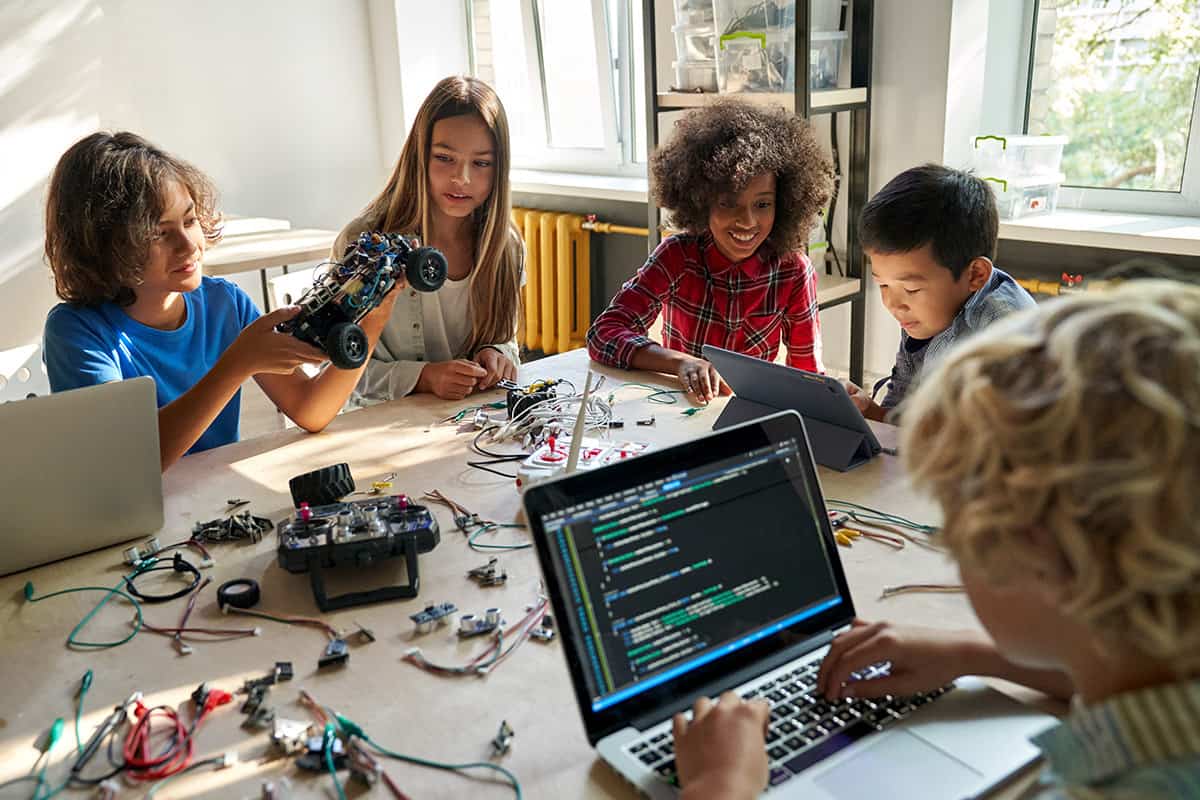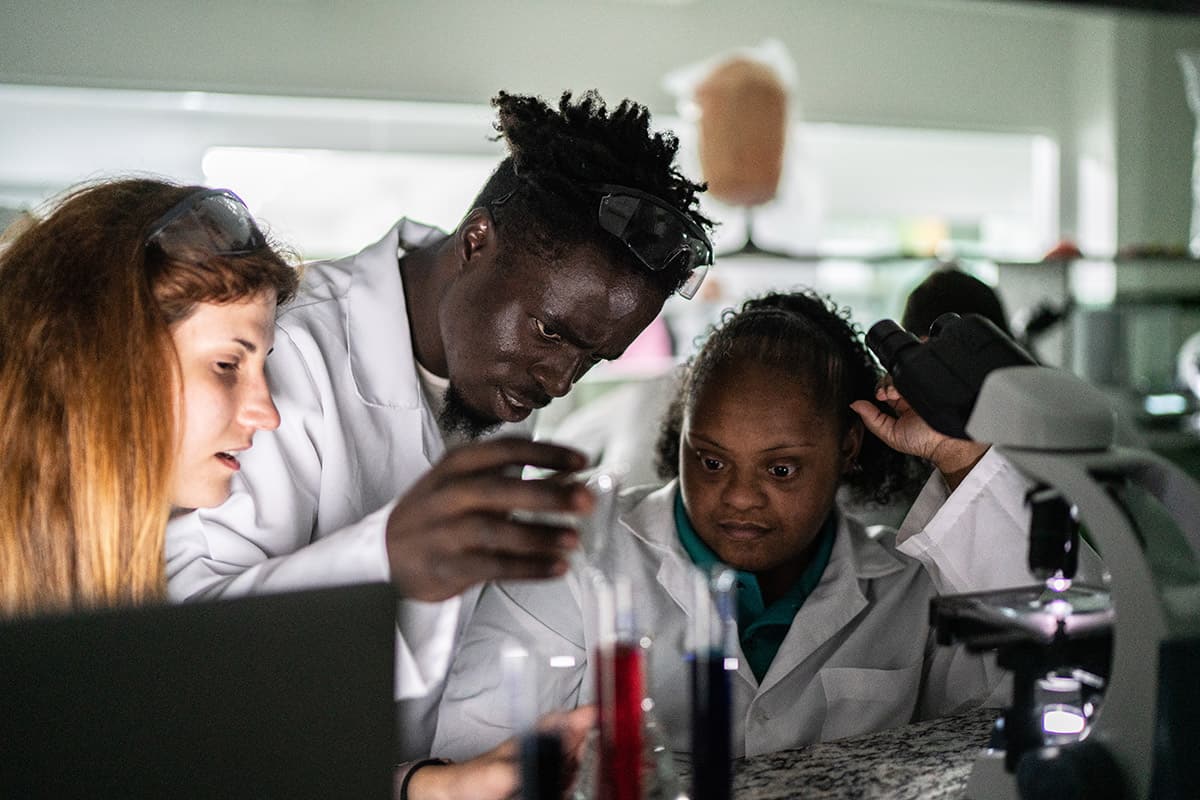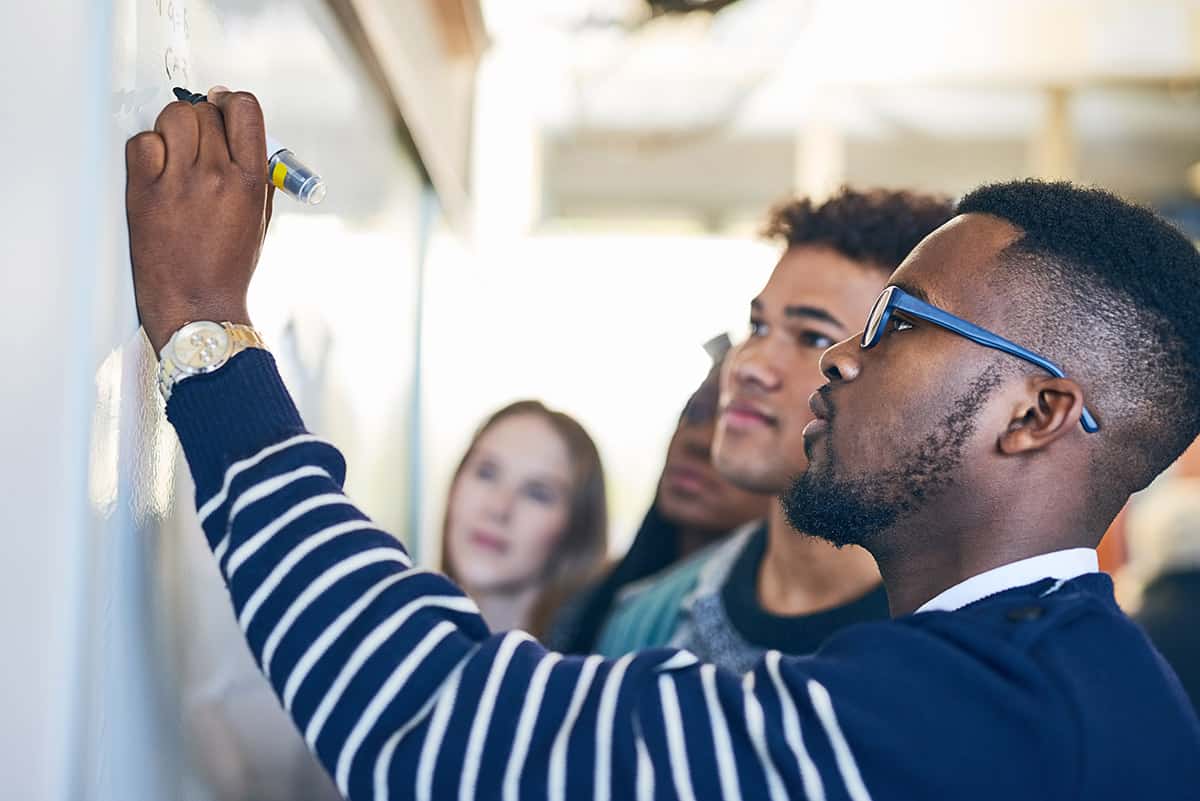The world faces countless social, environmental and economic problems that require complex solutions combining knowledge and expertise across many sectors. Veronica Benson, Andrew Mizumori Hirst and William Wakeham explain why physics degrees need to be revamped so that physicists can better tackle these vital issues
The world is always in a state of flux – and no more so than now. Triggered in part by the COVID-19 pandemic, it’s clear that new technologies, such as telemedicine, digital payments and industrial automation, are moving faster than ever. We also need to find ways to decarbonize the economy, deal with an ageing population and harness the power of artificial intelligence.
In the light of these challenges, it’s vital that universities give students the right knowledge and skills so they can create and develop the next generation of technological solutions to tomorrow’s problems. With their unique combination of high-level scientific knowledge, numeracy and problem-solving skills, physicists are well placed to meet these needs in a wide range of high-tech industries.
However, physicists often fall short on broader translational skills, such as effective communication, team working, creativity and the ability to find cross-disciplinary solutions to complex problems. Furthermore, traditional physics degrees often overlook the fact that many physicists do not end up in academic or physics-specific roles. Instead, they move into areas such as manufacturing, energy, finance and teaching, where they have to apply their knowledge in ways they have not been taught.
Ensuring enough physics graduates have the right mix of skills is a huge challenge for educators. It’s pleasing therefore that the Institute of Physics (IOP) revised its degree accreditation framework in 2022 to encourage universities to design more flexible physics degrees. Departments that want IOP accreditation now need to make translational skills more prominent, while placing an equal emphasis on knowledge and skills.
The new framework should ensure that physics graduates are better prepared for the world of work. It will give them “skills clusters” – combinations of translational and technical skills that are valued by graduate employers and can be used in many different careers. It will also encourage universities to teach and assess in innovative ways. Physicists heading into financial technology, cybersecurity or IT, for example, will need data-science and machine-learning skills alongside their core physics expertise.
We are also seeing the emergence of entirely new educational models that are challenging the traditional degree structure. Stanford University’s thought experiment Stanford2025, as well as UA92 in Manchester and 01 Founders in London, are all designed to attract students from more diverse backgrounds, and align more closely to employers’ needs. Rather than just being about what students learn, their focus is increasingly on how the students are taught and assessed.
But what would a physics degree look like if we were to start a new university or a new course entirely from scratch? How could we redesign physics courses to more closely match the skills that physics students and employers need? And what lessons can we learn from the way in which degrees were forced to adapt during the pandemic? Which changes were effective, and which were not?
Those were some of the issues that graduate recruiters and university physicists discussed during a series of IOP-supported webinars that took place in 2021. Organized by the UK’s South East Physics Network (SEPnet) and the White Rose Industrial Physics Academy (WRIPA), the webinars raised some fascinating issues that we summarize here. As the COVID-19 pandemic fades into the background, here are five important questions we need to ask ourselves if we are to create the physics degree of the future.
1. How do we teach students to tackle open-ended, unfamiliar problems?
Employers want graduates who can solve problems that are not necessarily well-posed or lie in a specific scientific area. However, those who recruit physicists often comment that candidates struggle with open-ended questions. This shortcoming may be due to the traditional “modular” nature of physics degrees, where each assessment only tests students on what they know about one particular topic.

Take optics, for example. Students are often taught and assessed in terms of topics such as diffraction and interferometry, which means they only know how to solve questions framed in certain ways. It’s a method of teaching that reinforces “siloed thinking”, with students not realizing – or knowing – that optics is also hugely relevant to areas such as robotics, advanced driver-assistance systems and healthcare.
An alternative approach would be for students to be introduced to a number of topics at one time, with assessments based on all prior learning. This “programme-level” or “portfolio assessment” method could enable students to make new connections across different areas, and help them think more creatively about ways to solve unfamiliar problems.
Problem-based learning (PBL) programmes are already offered by a number of institutions, such as the University of Maastricht in the Netherlands, and the new coding college 01 Founders in the UK. Students here work in small groups to solve real-world problems that incorporate four key learning principles. They build knowledge from experiences rather than rote learning (“constructive education”), and apply knowledge and skill to societal challenges (“learning in a relevant context”). Meanwhile, “collective learning” and “self-directed education” mean students learn from peers and begin to manage their own education.
In terms of our future physics degree, a PBL programme could mean students taking part in one group project per term, during which they apply their learning to solve research or technical problems based on global challenges, possibly posed by businesses. Students would develop a variety of skills, such as project management, report writing, communicating and collaboration, as well as learning to think creatively in order to solve open-ended problems.
We also think that physics educators can learn from their colleagues in engineering. Far too often it’s assumed that physicists will stay in academia, with students striving to get top grades and universities reinforcing the idea that academic excellence is the only important measure of ability. In non-university roles, however, you need more than just academic ability to succeed.

Engineers are much more aware of the realities of work. As well as using a variety of teaching methods that focus on the application of scientific principles, many engineering degrees do a far better job at engaging with industry and preparing their students for a variety of careers. We need much greater industry input into our future physics degrees to ensure we equip graduates with the skills that businesses need.
2. How do we account for students’ different learning styles?
The favoured method for teaching in universities, particularly in pure sciences, has long been the traditional lecture. However, the COVID-19 pandemic forced departments to try different approaches, including online sessions. It’s not been a smooth ride, with some undergraduates even having their tuition fees refunded because of complaints about the poor quality of tuition.
But there have been benefits. For example, some students seem more engaged and are more likely to ask questions in a chat box than they would if the lecture was face-to-face. Digital learning has also helped those with some disabilities or who face long commutes. What’s more, because online lectures are typically recorded with notes, the ability to return to recorded material later can be beneficial for reinforcing learning.
However, an over-reliance on online and recorded material can make it hard for students to choose and prioritize the resources they need. In addition, some students are not engaged by online learning, simply “switching off” during live sessions. Without face-to-face interaction, students lose the ability to interact with their peers and build their social skills.
The way that undergraduates study and learn has changed too. They rarely use textbooks, while libraries are now more valued as a space to study than somewhere to access learning materials. Tutorials have become more important for students to meet each other and staff in person. They are perfect for groups to work together to solve real-world problems, boosting their employability as well as their social skills.
But it’s not just about the students; academics are changing too. With staff and students returning to campus, academics have acknowledged the benefit of a hybrid form of teaching to engage more undergraduates. A tailored, “Netflix-type” offer featuring both in-person and virtual sessions could help meet a greater number of students’ individual learning needs and preferences to cover the same content.
3. How can we assess students on their ability to master challenges and apply their knowledge?
Traditionally, physics students were assessed through “closed-book” exams, where they sat in an exam hall for a fixed period of time and were tested on everything they know on one particular subject. But with the shift to online learning during the pandemic, educators have been forced to try new approaches to get a better understanding of a student’s ability and potential.
Continuous assessment, for example, has been introduced in some cases via regular online quizzes and “gamification” to measure progress and highlight gaps in understanding. It’s possible that, in the future, different online assessment methods (such as reflective journals, or patchwork assessment) could be used to assess the same academic content to suit students’ preferred learning style.
But should we go further? Why don’t we assess students based on their depth of learning (in other words, their ability to transfer and apply learning in different contexts) rather than on their ability to simply regurgitate information in order to progress to the next teaching level?
This alternative model of learning already exists in primary schools, where pupils of varying ages sit in different groups depending on their ability to accomplish certain tasks commensurate with a “mastery level”, rather than being separated according to age. Learners must demonstrate mastery in unit tests, typically achieving an 80% mark, before moving on to a new task. Mastery learning can be defined as a level of deep understanding about a topic that is maintained and can be recalled over time.

In contrast, university students taking traditional “summative” tests typically need to get only 50% in their exams to move onto the next year of study. The problem with this approach is that students often end up with a superficial and shallow knowledge. What’s more, they often forget the information and are unable to apply it to different contexts. That’s no good for employers, who want graduates who can do more than just memorize facts and information.
If the model used at primary schools were adopted in a university setting, students would continue the cycle of studying and testing until the mastery criteria are met. Those who do not achieve this deeper level of understanding would be given extra support via, for example, tutoring, peer-assisted learning or small group discussions.
4. Can technology be used to enhance or replace laboratory work?
When it comes to experimental work, undergraduates are traditionally made to attend face-to-face lab sessions where they work their way through specific, well-known experiments. As well as developing practical skills, these timetabled hours give students structure to their working day, helping them plan and manage their time, and allow for group work and social interaction. However, the pandemic forced physics departments to reassess this approach almost overnight, and rapidly refashion experiments for an online world.
Some better-resourced universities were able to provide students with individual kits while others relied on video demonstrations. One department (which wishes to remain anonymous) offered some of their undergraduates socially-distanced, face-to-face lab sessions while others took part in virtual lab work online. This approach, while resource-intensive and challenging, did provide interesting results.
The assumption had been that students working online would have a less valuable experience than those in the lab. It turned out, however, that those very same students enjoyed working on their own – particularly as they could still interact with others to exchange ideas via chat forums. As a result, this department decided to continue with this approach to digital lab teaching.

For some students with particular learning styles or needs, virtual labs are simply more effective. The Open University – which makes its students do experiments virtually through the OpenSTEM Labs interface – has also found that this method lets students learn from their mistakes. At in-person teaching labs, there’s often no time to make errors or repeat experiments as you would do in real research. Virtual platforms offer that flexibility and provide feedback about mistakes via a live feed.
For a future physics degree, a hybrid approach – with a mix of virtual and in-person experiments – seems essential. Students could, for example, go online to plan their experiments ahead of a class so that their time in the lab is more focused and involves more group work. They’d gain from the practical and social benefits of the real-lab experience, while also improving their independent learning.
Reduced time in the lab would also be cheaper for universities and free up vital lab space for other activities. We know that physics is an expensive degree course and the inclusion of high-quality virtual experiments, especially towards the start of a physics degree, could be vital in showing a university is ahead of the curve compared to others.
5. How do you attract and support a diverse community of students and staff in physics?
Most businesses understand that a diverse and inclusive workforce can lead to better ideas, decision-making and success. They realize the importance of reaching a wider talent pool to attract the best graduates, and of reviewing their recruitment processes and working environments to ensure they are more inclusive.
Universities need to do the same. Higher education is ultra-competitive, with degree courses increasingly measured and evaluated on the success of graduate employment and student satisfaction ratings. Universities need to ensure they provide a truly inclusive environment to better attract and support talented students from all backgrounds, and enable them to meet their full potential.
Specifically, universities need to do more for under-represented groups, including people with disabilities, those from minority communities and those from lower socio-economic backgrounds. Indeed, students with social communication difficulties, including autism spectrum disorder, have been found by the UK’s Association of Graduate Careers Advisory Services to be the least likely of all disability groups to be in full-time employment and the most likely to be unemployed. This is of particular concern for physicists because data suggests that students with social or communication impairment are more commonly found in physics programmes than any other undergraduate subject.
So what can we do to support university students with disabilities and learning needs? While school pupils are typically given an education, health and care plan (EHCP), undergraduates are not universally evaluated in this way. And even when information about a student’s disability or learning needs is given to a university, it is often not shared with teaching staff and departments because of concerns with confidentiality.
Staff therefore need to be trained so that they can spot problems, and point undergraduates to relevant help and support. We also need to find ways to share information about students’ learning needs when they enrol at university, while encouraging the students themselves to declare any disabilities they have.

Physics degrees also need to do a lot more to attract students from diverse backgrounds by widening access opportunities to attract the best talent. There has been some progress, with most physics departments already having well-established Equality, Diversity & Inclusion (EDI) committees and policies. However, we need to make sure that staff themselves are from a wide range of backgrounds too. They act as role models and mentors, and it’s important staff take part in EDI initiatives. But we must avoid making those who are from under-represented groups themselves shoulder all the responsibility for solving diversity issues. Empowering more staff to be accountable for diversity issues means the work isn’t dumped on just a few “specialists” but is shared by many people.
So what does a physics degree of the future offer?
With the changing job market, growth of digital technology and greater awareness of diversity issues, physics degrees need to evolve.
Employers increasingly want graduates with good team work and problem solving skills, and it is possible to provide these via academically rigorous physics degrees. In fact, businesses do not want physics degrees to be “dumbed down” in any way. Instead, educators need to consider how these skills can be embedded within the curriculum so as to prepare students to better apply their knowledge at work.
Furthermore, across the higher education sector, new ways of teaching and different university models are being set up to attract and meet the needs of all students. These new approaches to curriculum design – along with changes to the IOP accreditation process – offer ideas about how the physics degree can evolve to equip every student with the skills and knowledge needed for future employment markets.
